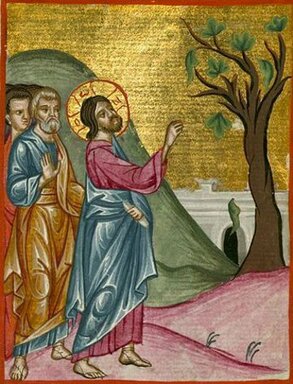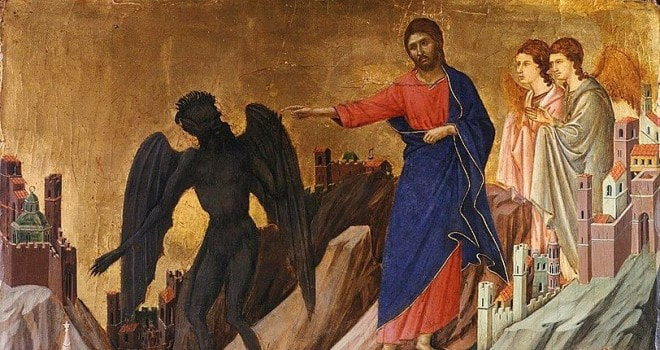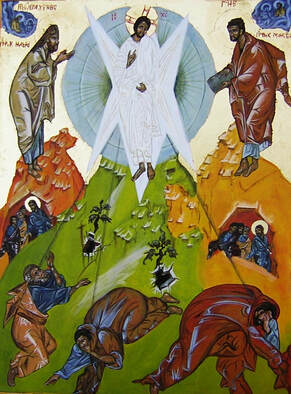
What is it about Jesus and figs?
Our passage today seems innocent enough. Jesus tells a parable about a fig tree given a death sentence because it isn’t bearing fruit. Nothing too sinister there. However the gospels tell us of another interaction that Jesus has with figs that is more troubling. Matthew and Mark, with slight variations, record an incident in the final days of Jesus’ life involving a fig tree. You might recall the incident. It occurred at the end of the day on which Jesus entered Jerusalem, the day we observe as Palm Sunday. Jesus was hungry and saw a fig tree. On closer inspection, Jesus discovered that although the tree had leaves, it did not have fruit. Jesus cursed that fig tree and the next day the disciples discovered that the tree had withered down to its roots (Mark 11: 14, 20; Matt. 21:18-20).
Apart from this fig tree, nowhere else in the gospels does Jesus curse a living thing. Nowhere does Jesus cause the death of a living thing. What could be so bad about a fig tree not bearing fruit?
It is true that caring for fig trees was hard and frustrating work. Fig trees require constant irrigation. They rapidly deplete the soil of nutrients and so the soil needs constant fertilizing. The bark of a fig tree contains a caustic latex that often irritates the skin. The wood is hollow, so it can’t be made into anything, not even firewood. And if that’s not enough to convince you never to raise fig trees, the kind of fig tree native to Israel took three years of constant, high maintenance care before they were mature enough to bear fruit. But figs were worth it. You could get 2-3 harvests a year out o f a good tree, and figs could be easily dried and preserved for times of famine, or long journeys, and they had medicinal purposes.
But it would take more than this for Jesus to curse a fig tree.
The fig tree has the distinction of being the only fruit named in the Garden of Eden. Recall it was the large leaves of the fig tree that served as the first clothing for Adam, who realized he was naked after he and Eve disobeyed God.
Because of its usefulness, the fig tree was a symbol of security and success throughout scripture. Solomon’s reign was depicted as a time when everyone lived in safety, under their vines and fig trees (1Kings 4:25). Who could top it: sitting under your fig tree, outside your house, no one bothering you. That was life. It’s what everyone aspired to. In his Nobel Peace Prize Acceptance Speech in 1964, Rev. Dr. Martin Luther King Jr. brought together the following biblical images when he said: “ I still believe that one day mankind will bow before the altars of God and be crowned triumphant over war and bloodshed and nonviolent redemptive goodwill proclaimed the rule of the land. And the lion and the lamb shall lie down together, and every man shall sit under his own vine and fig tree, and none shall be afraid. I still believe that we shall overcome.”
A barren fig tree on the other hand stood for judgment of sin. Jeremiah talked about spoiled, bad figs, a nation gone bad. Hosea prophesized impending suffering for turning away from God: “I will lay waste her vines and her fig trees…” (3:2).
So when Jesus tells this parable about the barren fig tree and later curses a fig tree before his death, they are not arbitrary hate crimes against figs. Jesus is acting in the prophetic tradition of his people. He is invoking a powerful, well-known image, which everyone around him understands. A barren fig tree stands for someone who has sinned and fallen out of favor with God.
This parable about the barren fig tree comes to us as Jesus is making his way to Jerusalem. His destiny is drawing closer and time is running out. His language and teaching is becoming stark and forceful. “I came to bring fire to the earth and how I wish it were already kindled!” He exclaims. “Why do you not judge for yourselves what is right!” he demands his disciples. “You must be ready!! “He exhorts.
And now his disciples are talking about those Galileans who were brutally massacred by Pilate while offering their sacrifices in the Temple. What sinners they must’ve been! They discussed. Jesus listened to them. He wondered: can they see the bigger picture? Do they have any compassion for these victims or their survivors? I wonder how Jesus must have felt at that moment. He had spent the last three years of his life, living with these people.
Three years of hearing the gospel preached and taught. Three years of healing the sick, casting out demons. Cleansing lepers. Eating with sinners – and forgiving sins. Three years of miracles. Three years of confronting religious hypocrisy. Three years of living, cultivating the soil, irrigating the earth, making things ready.
Three long years, and now time was running out and this was what they had to show for it? “Jesus what bad things did they do?” Jesus what sin did those 18 commit to have the tower of Siloam fall on them?
These thick-headed disciples are like the fig tree in the parable -- still barren. Three years are up and there’s still no fruit. No wonder the owner is ready to cut this tree down. It has become a curse – like a millstone around the neck. And the disciples, for all the care Jesus offered them, still didn’t get it. Did it feel, in that moment, like a big waste of time?
It reminds me of a riveting scene in the made for TV movie, “Jesus ” by Gary Oldman. Jesus is in the Garden of Gethsemane on the night before his death. Satan appears, dressed like a very sympathetic fellow. “Why are you going through this, Jesus? You can call it off Jesus. You don’t have to suffer. What’s it going to accomplish?” Satan goes on to show Jesus scenes of future conquests, bloodshed, war and destruction – all done in his name. “Killing in the name of Christ will be a big business, Jesus.” Satan sighs. Pointing to the sleeping disciples, Satan shakes his head sadly, “They don’t have the capacity to love the way you want them to.” Then as the mob led by Judas draws near, Satan coaxes, “you can stop it, Jesus, you can take charge and end war, poverty and hunger. You don’t have to do it this way.” Satan is right. Despite all that Jesus does, for us, we have not been symbols of the abundant fig tree. Some times people have produced. Many times we haven’t, despite the tireless labor of our Gardener.
Like the gardener in the parable, Jesus takes the gamble. The gardener was not willing to give up on that one barren fig tree. He was not willing to give in, to cut it down. Give me one more year, he asks the vineyard owner. “I’ll take extra good care of it. Give it extra fertilizer. Dig the soil and we’ll see. In the same way, Jesus doesn’t give up on his disciples. One way, with time, they will bear fruit.
For one barren fig tree, the gardener was willing to invest another year of his life. How much more is Jesus willing to give you and me. Because Jesus sees more in us than we can. We see the failure, the waste, the loss. When you or I are ready to call it quits, to pick up the ax, Jesus calls it differently.
That’s’ what Jesus asks of us this day – as we approach the mid-point of Lent. Knowing our barren branches – he asks us to give him one more year. What is one year to us, who have squandered so many moments in passing, in empty diversions that neither satisfy nor last? Join in the vision of the Good Gardener. Put down the ax. Work the soil. Be the fertilizer. Dig in deep. Prune the dead branches off and tend to the developing blossoms. Because the greatest curse we can face is not death. The greatest curse is a life that does not bear fruit. That is not God’s plan for us. We are called to bear fruit, fruit that endures.
One more year. Let your life bloom – you can bring security and rest, nourishment -- you can be a person around whom people gather to experience hope – a bringer of peace and prosperity for searching souls, for those who wonder about the compassion of God when towers fall and tyrants reign. No our God is a gardener, like Jesus who brings out of our barren lives such fruit…like Erica Jong describes…
One bite into
a ripe fig
is worth worlds
and worlds and worlds
beyond the green
of Eden.
Amen.
"Figs" by Erica Jong, from Love Comes First. © Penguin Group, 2009.



 RSS Feed
RSS Feed